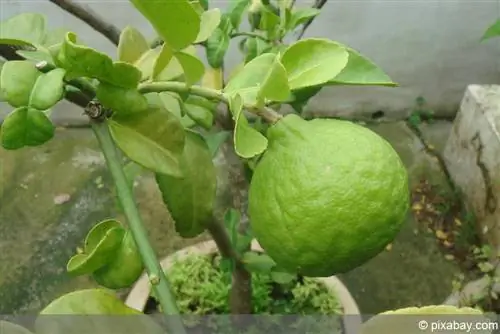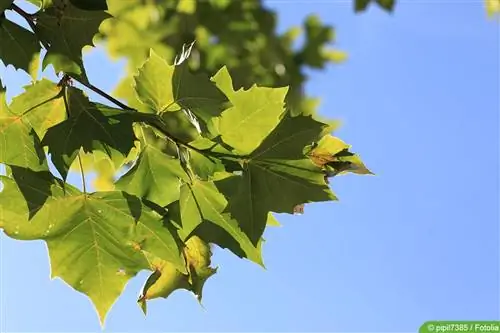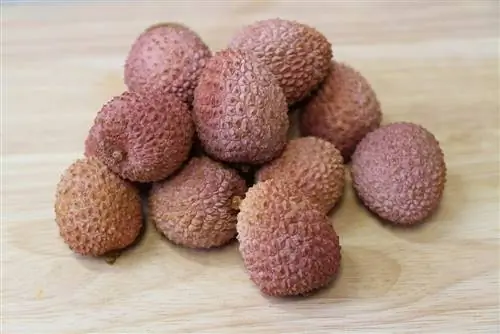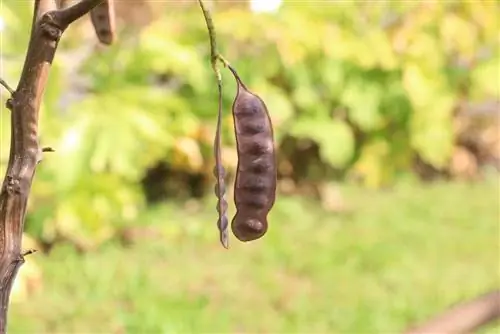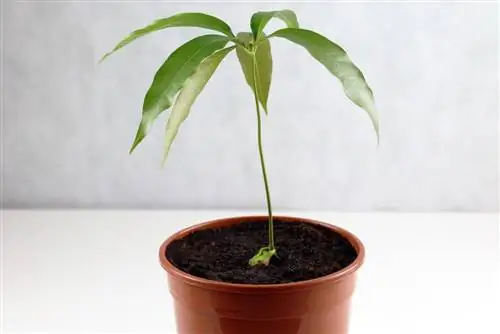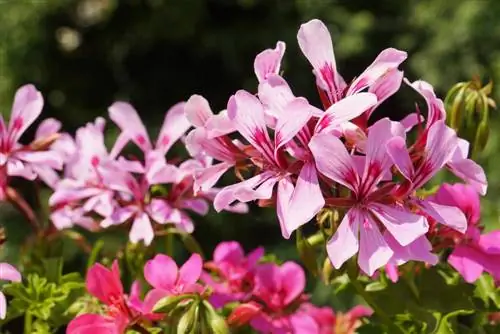- Author admin [email protected].
- Public 2023-12-17 03:39.
- Last modified 2025-01-24 12:45.
The lime, the little sister of the lemon, exudes a Mediterranean flair and thus satisfies our longing for far away places. The strong green leaves look elegant, the small flowers exude an intense scent in summer. And if the care is right, the aromatic, yellow-green fruit will also work.
Varieties
Lime comes in different varieties: caviar lime, Roman lime, mandarin lime and Palestine lime are some of the well-known varieties. All of these varieties have similar care requirements. The Mexican lime expects a lot of warmth and light. It causes problems when overwintering and usually needs an additional plant lamp. The common lime (Citrus × latifolia), also known as the Persian lime, is the easiest variety of lime.
Location
Unlike in southern climes, where the climate is ideal for all citrus fruits, in this country they only thrive if they are in a suitable location. If this is chosen incorrectly, even the best care will not help. The ideal location for the lime is bright, fully sunny but still protected from the wind. In the warm season, the lime bucket can be placed outside in the garden or on the balcony.
Place the lime plant so that it gets sunlight as early and as long as possible. The lime is one of the smallest citrus plants that puts all its power into producing aromatic fruits. Therefore, make sure that other plants or house walls cannot cast a shadow on the lime. When changing locations, the lime always needs some time to get used to it. Be especially careful when moving outside that it is not immediately exposed to intense sunlight. At the beginning, only put the lime out for an hour and gradually increase the time.
Planting soil
In their homeland, limes grow into small trees in the wild. North of the Alps, cultivation is only possible in pots or containers that have sufficient drainage holes in the ground. Limes need loose and well-drained soil. However, the bottom layer should be a drainage layer of gravel or gravel. You can buy ready-mixed citrus soil in stores. Cactus soil is also suitable.
Tip:
You can make your own mixture quite cheaply. To do this, mix good garden soil with a little sand and broken gravel or expanded clay.
Pouring

The lime plant requires significantly less water than the lemon, which is more common in our country. Therefore, be careful not to overwater just out of habit. How much water the lime plant actually needs is primarily determined by its growth. Growth, in turn, can vary and is highly dependent on the weather. To put it simply: The lime needs water when the top half of the soil is dry.
It is not enough that the visible surface layer is dry. The layer of soil immediately underneath may still be wet. If possible, use rainwater as irrigation water. Thoroughly soak the lime root ball with water and then wait several days before watering again.
Tip:
A moisture meter whose probe is inserted deep into the soil can reliably help you find the right time for watering.
Fertilize
In the period from May to June, the lime delights us with its wonderfully white flowers before the aromatic fruits are formed. During this growing season, from spring to summer, their nutrient needs are highest. The lime plant is fertilized weekly with a special, mineral citrus fertilizer. This contains all the necessary nutrients such as nitrogen, calcium, potassium and iron in the right composition.
The fertilizer is dosed according to the packaging instructions and added to the irrigation water. Therefore, only fertilize if the plant needs water. The need for water is also a sure sign that the plant is growing. In this case, fertilization is also appropriate. If you fertilize without water requirements, there is a high risk of over-fertilization.
In winter, the lime takes a break from growth and rest. During this time, the lime does not need any fertilizer. Stop fertilizing in the fall.
Note:
Organic fertilizer is less suitable for the lime tree because its nutrients are only accessible to the plant if they are converted appropriately by microorganisms. However, container planting is not a particularly good breeding ground for microorganisms.
Repotting
The limes that are not hardy must be grown almost exclusively in containers. Regular repotting is a basic requirement for he althy growth. The right time is February and March. But repotting is also possible after the Ice Saints, when the limes come outdoors. Young plants usually need a larger pot every year, while older trees only need it every two to three years. Repotting is also necessary if the roots grow out of the drainage holes.
- For repotting, use a pot that is 2-3 cm larger; a clay pot with a hole is ideal
- First place a drainage layer consisting of gravel or clay balls. A few centimeters high is enough.
- Put some citrus soil in the pot.
- Compact the soil by jerking the pot upright.
- Now place the plant in the middle of the pot and fill in soil around it.
- Press the soil with your fingers.
- Water the plant well.
Tip:
If the lime tree is already in a very large pot, it is sufficient if just the top layer of soil is replaced with fresh soil. Repotting is a stressful situation for the sensitive lime plant. It can therefore happen that it then loses its leaves. Don't worry, new leaves will sprout on the branches after a few weeks.
Topiary
A lime tree grows quite slowly, so there isn't really much to cut. A regular shape cut is not possible. If the tree is he althy, drastic pruning is not necessary. If the lime tree is out of shape, it can be cut back, like all other fruit trees. The best time for a topiary cut is at the end of the wintering phase, then the lime loses the least strength. When cutting, proceed as follows:
- Use only clean and sharp secateurs
- Disinfect the secateurs with alcohol
- Remove shoots that grow inwards
- Remove shoots that cross other branches
- If necessary, you can remove the light green shoots entirely
- Short thinner branches by a third
- Short thicker branches by two thirds
- Short the main shoot only so far that it still towers over the side shoots by 10 - 15 cm.
When pruning, ensure that enough light can reach the crown, but only cut as much as necessary. No more!
Conservation cut
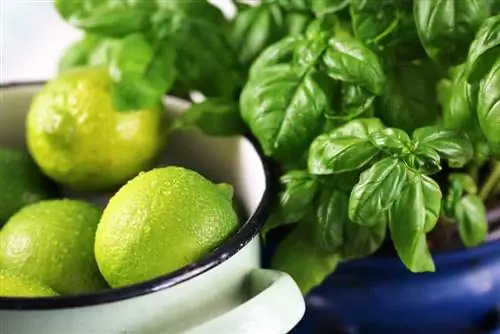
Individual branches may die during the cold winter. You should remove these. The best time for this is also the end of the wintering period until the beginning of spring at the latest.
- Use only clean and sharp secateurs
- Disinfect the secateurs with alcohol
- Remove all dead branches and twigs. Cut slightly beyond the dead area and into the green wood.
Educational Cut
Young plants should be pruned regularly but cautiously so that they develop a beautiful, bushy crown. The main pruning should be done before the start of a new growing season. If further correction is warranted during the summer, individual shoots can be cut in moderation.
Propagation
A lime seed can be put in soil and watered, with a bit of luck it will develop into a plant. However, because the limes offered here often come from hybrid plants, the resulting plant may be sterile. Unfortunately, you only notice this after about seven years, when you can expect fruit for the first time.
Lime can be safely propagated from cuttings. Propagation by grafting or mossing (rooting on the mother plant) requires a lot of patience and is more for professionals. However, plants propagated in this way bear fruit much earlier.
Harvest
The lime fruits are ready to harvest about five to six months after flowering. They are picked when green. However, some varieties have a yellow skin. The fruits are the long-awaited icing on the cake for every lover of these plants. Don't worry, it doesn't have to be a lack of care if your lime tree isn't bearing fruit yet. In this country they take many years to do this. It can even take a whole decade for the lime tree to bear fruit.
Pests
In winter, lime trees are more susceptible to sucking pests than in summer. Scale insects, mealybugs, mealybugs and spider mites are the most common and must be combated immediately to ensure that the damage is limited. To combat it, commercially available agents are injected. The treatment usually has to be repeated several times because the pests also reside in the soil and are difficult to drive away with the products there.
Tip:
You can easily make an environmentally friendly spray against sucking pests yourself by mixing water and a little soft soap.
Diseases
Black coating on leaves and dried plant parts are a sure sign of fungal infection. Depending on how far the infestation has progressed, you can wipe off the leaves or cut off the affected branches straight away. Be careful not to spread the fungal disease. When cutting the diseased plant parts, use disposable gloves that you can throw away afterwards.
After cutting, clean the cutting tool thoroughly with water and then disinfect it with alcohol. If the infestation is very severe, the lime may only be saved with the use of chemical agents.
Overwintering phase
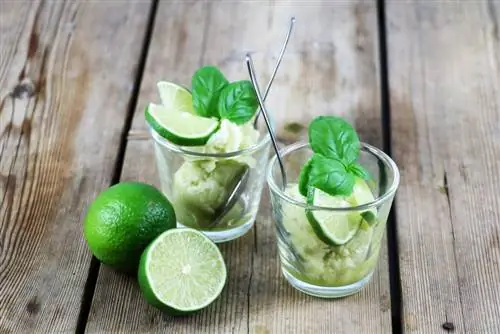
Lime are not hardy and cannot overwinter outdoors. When temperatures drop below 12°C, it's high time for winter quarters. However, at the latest when night frosts are expected, the lime tree needs to be cleaned. If the weather allows it, it can go out again in April, but at the latest after the Ice Saints.
Winter quarters
Lime probably comes from areas in India where it is consistently warm and humid. Bright rooms or winter gardens facing south and with room temperatures of around 20 °C and high humidity are well suited for wintering. A heated greenhouse is also a good winter quarters. However, usually only cooler rooms are available. Care should be taken to ensure that temperatures do not fall below 5 °C. Even the cool rooms should be bright.
Note:
Lime cannot tolerate direct contact with underfloor heating, which radiates too much heat. You should also avoid being in close proximity to radiators.
Winter Care
Your lime tree is taking a break, but not the care. It continues and just adapts to the demands of winter.
- Lime must never dry out completely, even in winter quarters. Water them occasionally with lukewarm water. The cooler the location, the less water is needed.
- If the lime loses leaves, be particularly sparing with watering.
- If the lime has lost all its leaves, stop watering completely.
- Spray limes regularly with water to increase humidity.
- In general, the warmer the lime is, the more light it needs. If the wintering room is cold, it should not be too bright.
- If the ratio of light and heat is not optimal, there is a risk of leaf loss.
- A plant lamp is useful when there is not enough natural light available.
- Fertilizing is not necessary.
- Check your lime tree regularly for pest infestation and diseases. Take appropriate action if necessary.
If your lime tree copes well with the chosen winter location, you can keep it next winter. Otherwise, adjustments may need to be made.
Note:
The lime can react negatively to the change in location in the first few weeks. Hectic reactions are not appropriate. Be patient and wait.
Common care mistakes
If the lime tree is vegetating, in addition to pests and diseases, care errors could also be to blame.
- Rolled leaves are a sign of lack of water but also wet roots.
- Iron deficiency turns the leaves yellow. The soil pH may be too high and iron cannot be absorbed by the lime. It should be lowered with acidic fertilizer.
- Too little light and too much water lead to soft shoots and so-called monster growth.
- Bright and white leaves appear when there is a lack of nutrients due to damaged roots. Too much moisture led to rot.
- If the root ball becomes too cold, the lime will drop leaves and fruits. From autumn onwards, watch out for night frosts and put the lime in overnight. In winter quarters, the pot can be placed on Styrofoam, which insulates the cold from the ground.
- Fruit falling off prematurely can also indicate a lack of light.

